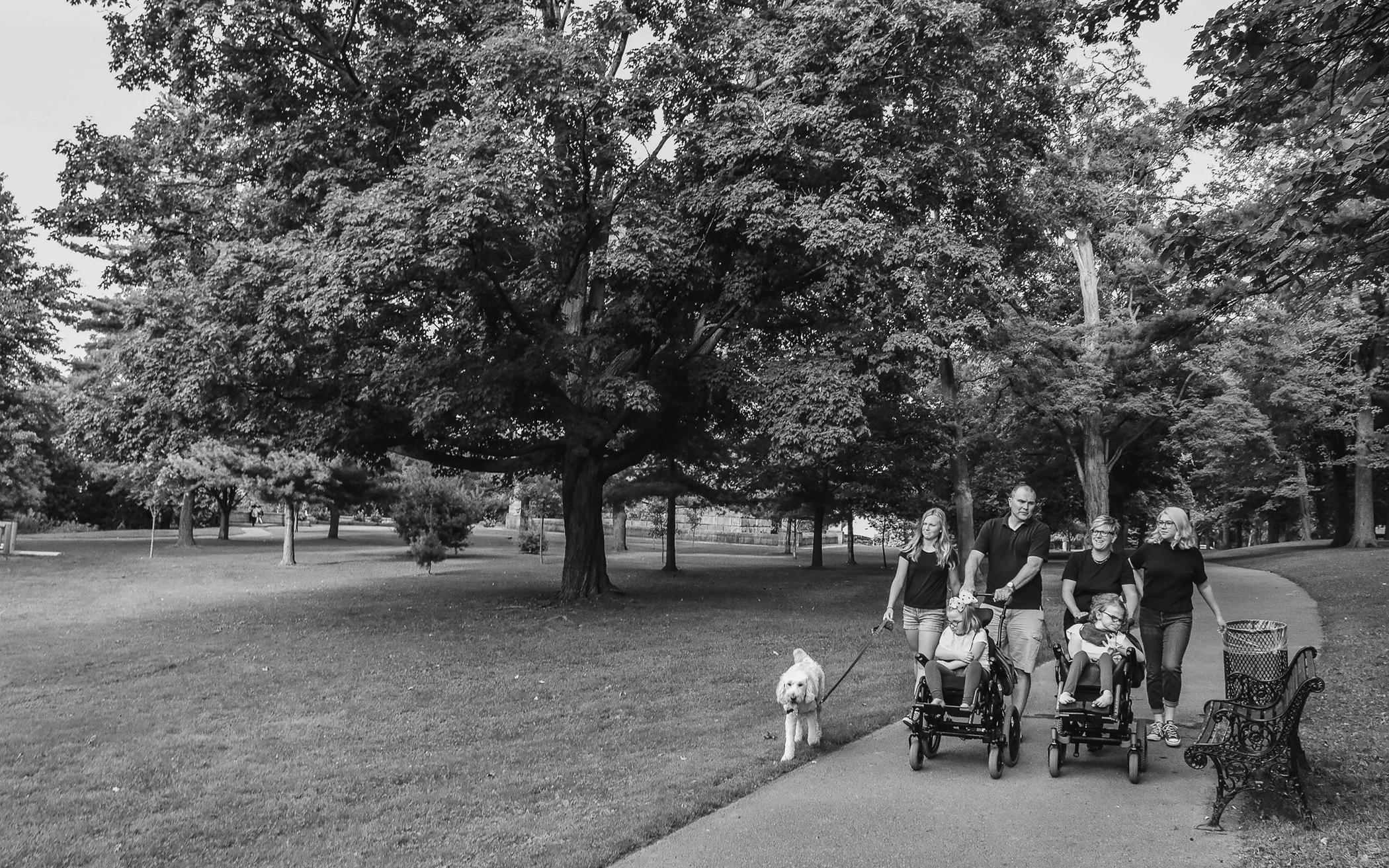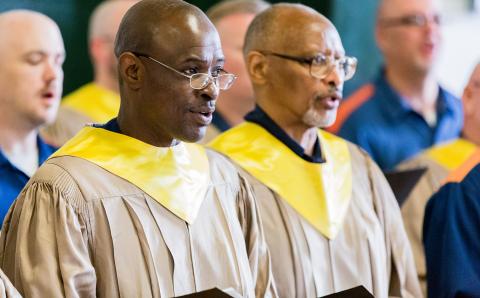In the fall of 2005, my husband, Ralph, and I announced the impending arrival of our third daughter. We were the parents of two preschoolers, 4-year-old Emily and 2-year-old Sophia, and we looked forward to being outnumbered by our children. Our anticipation turned to trepidation in December 2005, when we learned our baby was developing with some significant concerns.
Rachel Joy was born in May of 2006, and, in short, everything about her was unfamiliar. She wasn’t able to eat or breathe on her own, and her physical body was malformed, suggesting mobility and independence would be a challenge. After six weeks of testing, surgery, and training, we took Rachel home from the hospital. We tried to find a new routine, one that included a child who was diagnosed medically fragile with global developmental delay.
Before Rachel’s arrival, life as we knew it was with two little girls who loved to sing, color, and run to the park. They happily ate peanut-butter-and-jam sandwiches for lunch and slept in their bunk beds at night. They gave sticky hugs and left fingerprints everywhere. What we didn’t know was life with Rachel, one who would never eat peanut butter or walk or run anywhere. Rachel’s fingerprints will remain forever in medical files for gene research, and the only singing she’s offered is through the twinkle in her eye.
We tried to make the unfamiliar known and called those first years with Rachel “our new normal.” For the sake of our older girls, and also for friends and family who were at a loss for how to respond, we wanted to create a sense of ordinary happenings.
All of that turned upside down with the birth of our fourth daughter. The ultrasounds failed to see what was painfully obvious at the birth of Janneke Grace on March 14, 2009. When our little one finally arrived, she presented malformations and concerns just like her big sister Rachel. As Janneke lay under the warming lamp, our excitement was replaced by the weeping of everyone in the room.
Truthfully, Ralph and I sobbed like we had never cried before. The adrenaline evaporated, and the darkness that now enveloped us was intense. We knew we would have to kick at that darkness, waiting for it to bleed at least a glimmer of light. Whatever normalcy we tried to create didn’t last, and we were back in that space of fear and anxiety.
In my struggle to find something to hang onto, my dad reminded me of the words in Matthew 4 and 5. The people that followed Jesus were also struggling to hang on. They were living with sorrow, impairment, and disease and were considered “less-than” by the rest of society. When I was encouraged to read who was in those crowds, I understood why Jesus’ words went beyond the law and societal norms to reach into broken hearts.
“Jesus went throughout Galilee, teaching in their synagogues, proclaiming the good news of the kingdom, and healing every disease and sickness among the people. News about him spread all over Syria, and people brought to him all who were ill with various diseases, those suffering severe pain, the demon-possessed, those having seizures, and the paralyzed; and he healed them. Large crowds from Galilee, the Decapolis, Jerusalem, Judea and the region across the Jordan followed him.
“Now, when Jesus saw the crowds, he went up on a mountainside and sat down. His disciples came to him, and he began to teach them.
“He said, ‘Blessed are the poor in spirit,
for theirs is the kingdom of heaven’” (Matthew 4:23-5:3).
So begins the well-known Sermon on the Mount.
Today, the word blessed is used and overused in many contexts, all suggesting that blessed is when good things happen. Yet Christ’s use of the word blessed in this context is extended to those who are in the lowest of lows. Sadly, this message was missed by his disciples (John 9) and the leaders of the church that followed. Over the centuries, those who struggled with impairment or disease were often poor, cast out, or seen as cursed.
This reality is so different from the work of God, who came in human form, defied cultural norms, and sat among the least of society. Our creator used stories with surprising twists to share much-needed good news, comforting the afflicted and afflicting the comfortable (a phrase coined by Finley Peter Dunne, a Chicago newspaper columnist, in 1902).
I wonder if we are still missing the message from that sermon on the mountainside. We’ve developed (or maintained) an unhealthy obsession with and misplaced admiration of fitting in, of falling within society’s bell curve of normalcy. We find comfort in predictable patterns and milestones. I wonder if we need to rediscover the biblical witness through the lens of disability. In his book Vulnerable Communion: A Theology of Disability and Hospitality, associate professor of theology Thomas Reynolds writes, “This … requires rethinking human dependency and vulnerability in the context of the cult of normalcy that dominates North America” (p. 70).
Some would argue the rise of the terms disability and normal began during the Industrial Revolution. A person with an impairment was not able to work efficiently according to society’s designs for building and manufacturing; they were “dis-abled” by the new societal norms. The average man who was able to successfully perform tasks and contribute to the larger economy was now defined as “normal.”
As the Industrial Revolution gained momentum, so did the study of human capability and social influences on human development. Eugenics looked at the impact of race and ability on humans. Measuring height, weight, head circumference, skin color, and intelligence became ways to quantify “normal.” When measurements didn’t fit in the central bell curve of “normal,” a person was considered deviant and unfit. Not surprisingly, as the idea of “normal” became defined, institutions were built to house the deviants, allowing for segregation in the name of the nation’s safety and well-being.
Through the years, the concept of “normal” has remained. To this day, people desire to fit the standard; it is an assumption deeply embedded into our life and culture.
The fields of education and medicine are two clear examples where the cult of normalcy exists. In our schools, those with disabilities are encouraged or required to develop skills and techniques that mirror or mimic their non-impaired peers. Students with disabilities cannot flourish and become painfully aware of their differences when the classroom requires unrealistic, one-size-fits-all standards.
Accepting diversity in ability challenges the vision of a school and can lead to uncomfortable conversations about defining excellence and interdependence. In my work with Christian schools, I am aware of a subtle but prevailing fear and uncertainty among able-bodied school community members when it comes to welcoming students with disabilities.
In the medical world, impairments are seen as deviations from the norm, and children like Rachel and Janneke are featured at genetics conferences. Had my children been born a generation earlier, doctors would have advised institutional care. Thankfully, in North America, we are slowly shifting toward family-centered care, allowing for collaboration between families and medical caregivers. Still, much work is needed to understand treatment and therapy, and it is vital to consider the long-term effects and outcomes.
Theologian Stanley Hauerwas says we humans are afraid of differences, and we see those who are different from us as more of a threat than a gift. We are reluctant to change our routines to accommodate differences. We create our own communities based on this comfort and reluctance. In his book Becoming Human, Jean Vanier wrote, “We build walls around our group and cultivate our certitudes” (p. 39).
Though Ralph and I have not experienced intentional exclusion, over time we have felt less included and more alone as a family. It isn’t easy to join the rest of our family and friends who jump into the car for a road trip, grab a quick meal at a restaurant, or gather for fellowship in someone’s home when there are wheelchairs, feed pumps, diapers, medications, seizures, and chronic pain issues. We didn’t have family or friends with wheelchair-accessible homes until Ralph’s mom moved into a senior living residence.
Now that our girls are older, we’ve come to wonder if the problem with being included and fitting in is less about our girls’ disabilities and more about the ableist culture in which we live. Ableist culture and language refers to norms and words that devalue people with disabilities. Lennard Davis, a specialist in disability studies, suggests in his essay, Constructing Normalcy that “the ‘problem’ is not the person with disabilities; the problem is the way that normalcy is constructed to create the ‘problem’ of the disabled person.”
Though often unintentional, ableist culture and language create more limitations for those with disabilities. But we can instead, for example, value the created person first by saying someone uses a wheelchair for mobility—rather than saying someone is wheelchair bound. When we build wider doorways and accessible washrooms with adult-sized changing tables, we value the created person’s quality of life. These features allow for universal access in our churches, schools, and public spaces.
Moving away from the cult of normalcy means moving toward the inclusive vision of belonging. Rather than living the gospel of fitting in, let us consider how we can truly live the gospel proclaimed in the Sermon on the Mount.
The first step is person-first language. If we see disability before we see humanity, who is blind? Learn about the people in your community by name first. Become aware of recent changes in language that illustrate universal design and personhood, and know which words hurt. Recognize your own implicit bias and ignorance before you decide what to say. Develop a posture of listening to understand.
Second, let us move away from stigma and isolation toward collaboration and interdependence. Make decisions with people who live with disability, not for them. There’s a common phrase that echoes through the global disability community: Nothing about us without us. If you are making policies and procedures for including those with disabilities, consider that those with disabilities have the most important insights to contribute.
When preaching or teaching, use materials and words that promote diversity and universal experience. Reconsider inadvertent references to normalcy, such as assuming that everyone learns to walk or that everyone loves to play in the snow. Find ways to create physical spaces that are accessible to wheelchairs, mobility aids, and those with sensory sensitivities. Our Rachel is not able to have anything by mouth, but for several years I could sense from her body language and eye contact that she was intent on participating in communion. She now joins her church family by receiving the elements on her forehead; the wine-soaked bread is used to make the sign of the cross on her forehead. This is the accessible gospel at work!
We are a visually driven culture, significantly influenced by what we see. Consider who leads worship and ministry, who fills your places of worship, and who sits in the classrooms of your school. What good news do people see when they walk through your hallways and scroll through your social media platforms?
Develop a cross-generational approach to church ministries. Simply having a Friendship Ministries program on Thursday nights does not mean that you are an inclusive congregation. It’s a beautiful start, but the vision of inclusive belonging is about creating interdependence and connections, integrating all ages and abilities every day. When we work to foster a comprehensive spirit of belonging, it will have amazing residual effects when our youth grow into our leaders.
There have been significant changes for the better in society’s view of disability and normalcy. Still, some of the prevailing ignorance exists in the sentiment that disability is credible only when we can see it in the form of a mobility device or a unique body presentation such as malformed hands. It is hard to understand what we cannot see. Indeed, those who live with a non-visible disability are often exhausted from defending the disability.
We cannot forget that a significant number of people in our church, school, and neighborhood communities live with something that challenges their quality of life. In forgetting this, we risk losing parts of the body of Christ (1 Cor. 12). Learning to see possibilities instead of just the problems allows us to offer hope and encouragement to those who sit on the periphery of what the rest of us have perceived as normal.
About the Author
Sara Pot works for Edvance Christian Schools Association and the Niagara Children's Centre. The Pot family attend Jubilee Fellowship CRC in St. Catharines, Ontario.








